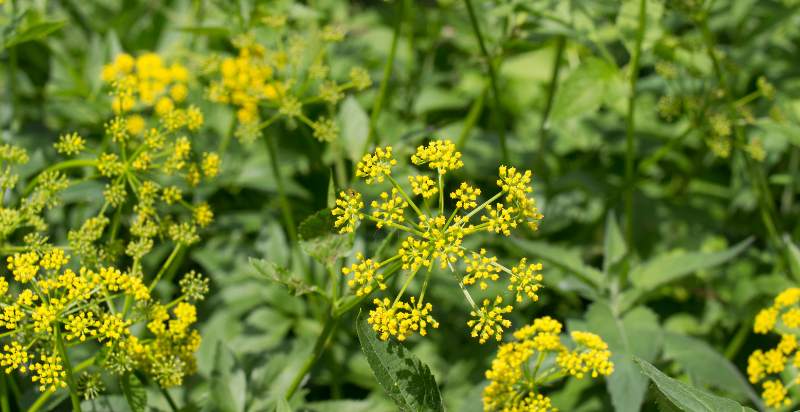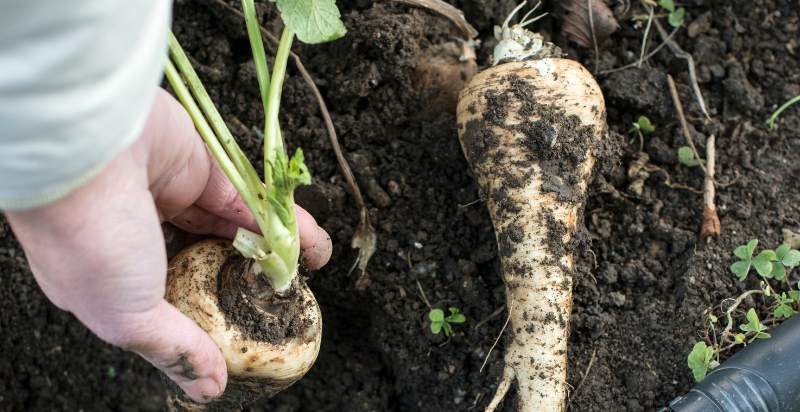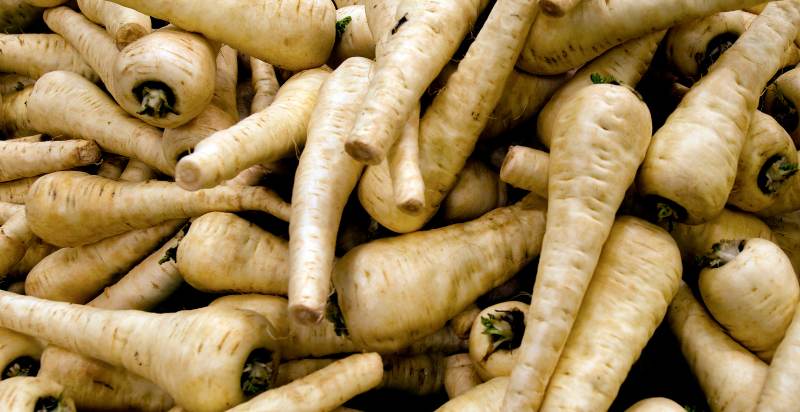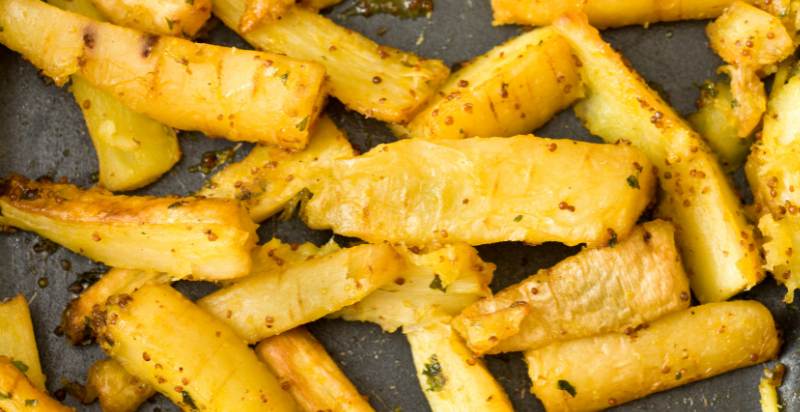Parsnip (Pastinaca sativa) is a root vegetable that belongs to the Apiaceae family and includes carrots, celery, parsley, and fennel. It has a sweet and nutty flavor with earthy undertones of pepper and spice. Parsnips are a popular ingredient in European cooking, found in soups, stews, roasts, and more.
As a root vegetable, it is also highly nutritious, providing essential nutrients like fiber, folate, manganese, potassium, vitamin C, and other B vitamins. Here is everything you wanted to know about Parsnip :
What is Parsnip?
Parsnips are a root vegetable that belongs to the Apiaceae family, which includes carrots, celery, parsley, and fennel. It is a white-fleshed root vegetable shaped like a carrot but has a more earthy flavor with pepper and spice undertones. Parsnips have been cultivated since ancient times and were once highly valued in European cooking.
History and Origin of Parsnip:
Parsnips have been cultivated since ancient times and were especially popular in Roman and Greek cuisine. The vegetable was further developed in the Middle Ages, creating various varieties. Parsnip is native to Eurasia but has spread worldwide and can now grow in most countries.
Types of Parsnip:
There are several varieties of parsnip, each with flavor and texture. These include the Hollow Crown, a large yellow carrot-shaped variety; the White Gem, which has a slightly sweeter taste; and the Stone, which is more flavorful than other types of parsnips.
Nutritional Value of Parsnip:
Parsnip is low in calories yet packed with essential nutrients such as fiber, folate, manganese, potassium, vitamin C, and other B vitamins. It also contains antioxidants that help fight inflammation and reduce oxidative stress in the body. As an excellent source of fiber, parsnip can help you feel fuller for longer, making it an ideal food for weight management.
Health Benefits of Parsnip:
Parsnips have a plethora of health benefits! They are packed with essential vitamins and minerals that can promote overall health. They are also high in fiber, which helps to promote digestive health and regularity. Additionally, they have been known to reduce inflammation and oxidative stress in the body due to their antioxidant content. Finally, they are a great source of potassium which is important for maintaining healthy blood pressure levels.
What are the different uses of Parsnip?
Parsnips are a versatile ingredient that can be used in a variety of dishes. They can be boiled, mashed, roasted, or added to soups and stews for added flavor. They also make great additions to salads and side dishes like coleslaw. Additionally, parsnips can be pureed into a delicious soup or blended into hummus for a healthy snack.
How to Plant Parsnip?
Parsnip is a root vegetable that tastes sweet, earthy, and nutty when cooked. It is often used in soups, stews, salads, and roasting. Planting parsnips requires patience as the seeds can take up to three weeks to germinate, but with proper care, they will produce an abundant harvest for many years. This section will give you all the information you need to grow your delicious crop of parsnips .
When to Plant Parsnips:
The best time to plant parsnip seeds is late spring or early summer after your last expected frost date has passed. In cooler climates, this could be anywhere from April through June, depending on where you live. Parsnip plant must be planted in soil at least 45-50°F (7-10°C) for best germination.
Soil Preparation:
For optimal parsnip growth, you will want to prepare your soil before planting the seeds. The soil should be well drained and high in organic matter such as compost or manure. Avoid planting parsnips if the soil has a large amount of clay or rocks, as they can inhibit growth and cause misshapen roots. To increase drainage and aeration, you may amend your existing soil with sand or peat moss.
Planting and Spacing Guidelines:
Once your soil is ready, it’s time to plant your parsnip seeds. Plant the seeds 1/4 inch deep and about 2 inches apart in rows 12-18 inches apart. As the seedlings emerge, thin them out, so they are spaced 4-6 inches apart.

How to Care for Parsnip Plants?
Once your parsnip plant are established, they will need regular care to produce a healthy harvest. Keep the soil evenly moist but not waterlogged by providing 1-2 inches of water per week. Fertilize the plants every 4-6 weeks with a balanced fertilizer such as 10-10-10 or 8-8-8 for optimal growth and nutrient uptake. Weeds should be pulled out often to prevent competition for nutrients and moisture.
Preventions from Pests and Diseases:
Parsnips are relatively resistant to pests and diseases, but it is important to inspect your plants regularly for signs of common problems such as aphids, carrot rust fly, or root rot. Proper spacing and crop rotation can help reduce the risk of disease.
Since parsnips take a long time to mature, there is also a greater chance of exposure to cold temperatures toward the end of their growing season. Covering them with row covers or mulch can help protect them from frost damage.

Harvesting Parsnips:
When it comes time to harvest your parsnip crop, wait until after the first few touches of frost have occurred in your area. This will make the roots sweeter and more flavorful. Gently loosen the soil with a fork and pull up the parsnips by their tops. Cut off any excess foliage before storing them in a cool, dry place for up to a few months or until you are ready to use them.
Following these steps and taking proper care of your plants, you can enjoy a delicious harvest of parsnips each year.

How to Store Homegrown Parsnips?
Homegrown parsnips should be stored in a cool, dark place such as the fridge, basement, or garage. It is important to keep them away from heat sources, such as direct sunlight, radiators, or ovens, as this can cause them to spoil quickly.
They will last for up to 3 months when stored properly. Before storing, ensure all dirt has been removed from the roots and dried off thoroughly – otherwise, mold could form. To further extend their shelf life, you can blanch and freeze the parsnips for later use.

How to Use Parsnips?
Parsnips can be used in various dishes such as soups, casseroles, salads, and even roasted for a delicious side dish. They have a sweet, nutty flavor that goes well with other root vegetables like carrots and potatoes.
Parsnip puree is also a popular choice for creamy sauces or mashed potatoes. Roasted parsnips are one of the tastiest ways to enjoy this vegetable – coat them in oil, herbs, and spices before baking at 425°F (220°C) until golden brown and crispy on the outside.
No matter how you choose to use them, homegrown parsnips are sure to enhance any meal.

Potential Risks From Parsnips:
Parsnips contain high levels of oxalates – a compound that can lead to kidney stones in sensitive individuals. Additionally, some people may experience an allergic reaction to parsnip consumption, so it is important to exercise caution when introducing them into your diet. Always consult your doctor before adding parsnips or new food to your diet.
Conclusion:
Parsnips are a delicious, nutritious vegetable with a sweet, nutty flavor that can be enjoyed in many different dishes. You can enjoy a bountiful harvest of homegrown parsnips with proper planting and care each year. Remember to store them properly and exercise caution when introducing them into your diet due to potential risks from oxalates. Enjoy!
Happy gardening!
- Everything You Wanted to Know About Red Tamarillos - June 2, 2025
- A Guide to Tulips: Everything You Need to Know & More… - June 2, 2025
- Guanabana: Description, Flavor, Benefits, And Uses - May 27, 2025

1 thought on “What is Parsnip? How to Plant, Grow, and Harvest Parsnip”
Comments are closed.